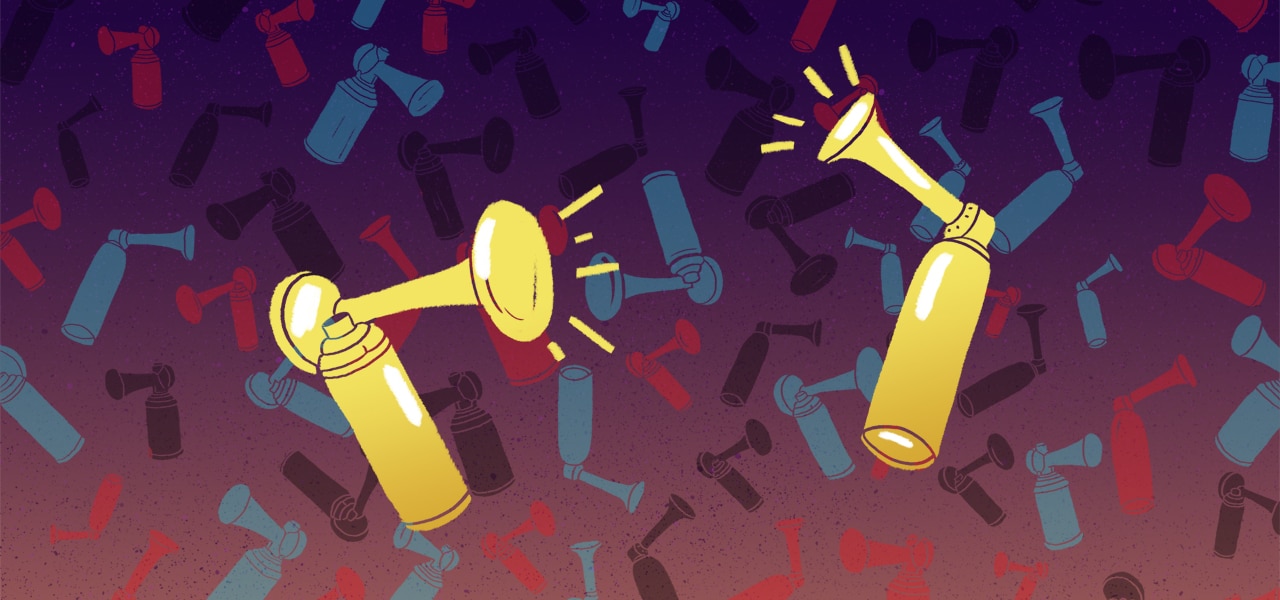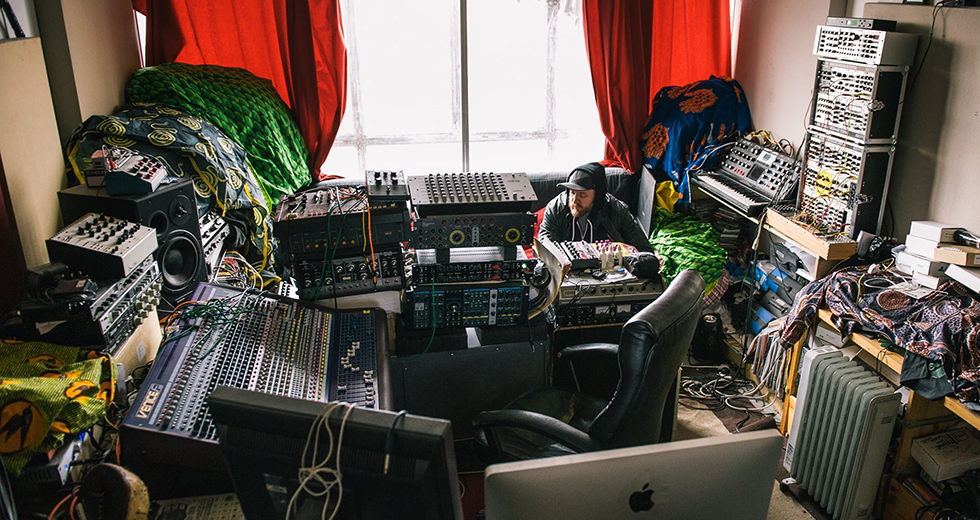
In Search of the Air Horn
Some sacred rites will eternally be shrouded in mystery. We will never identify the first Athenian who decided that a hecatomb of slaughtered oxen was essential for divine reward. Nor can we name the intrepid Aztec who plucked the psychedelic mushroom and first revealed Quetzalcoatl. And we almost certainly will never know the prophet who brought the air horn to popular music. All we know is that it’s everywhere.
“It’s like a uniform that you have to wear to school,” says DJ Mustard, 22, the ratchet rap ruler who produced “Rack City” and “I’m Different.” “I never used it much in my DJ sets until recently. I was more into glass breaking or dropping bombs. But it’s become a signature DJ sound, where like if you don’t have it, you ain’t cool.”
“It’s become overly cliché. DJs hit that when they can’t do anything else. Everyone’s just staring around and then boom…air horn,” adds Atlanta’s Burn One, who has produced and DJ’d for everyone from A$AP Rocky to Gucci Mane. “I’ve traveled all over the country during the last four or five years. It’s ubiquitous.”
You hear the air horn at rap shows and on pop radio, in reggae dancehalls and on the YouTube series: “Funny Air Horn Pranks.” It squawked on Damian Marley’s “Welcome to Jamrock” and electrocuted Drake, Eminem, Kanye West and Lil Wayne’s “Forever.” But who was the one honking hip-hop’s Ur air horn? Several people told me their earliest recollections came from British DJ Tim Westwood. Others directed me towards New York DJs Funkmaster Flex, Green Lantern and DJ Whoo Kid.
DJ Jazzy Joyce was officially the first to play the air horn on Hot 97, but Cipha Sounds patented it.
But all roads eventually lead back to Cipha Sounds, a DJ for New York’s Hot 97. A Bronx native who frequented underground dancehall parties in Brooklyn and Queens during the mid-to-late 90s, the Hot 97 Morning Show co-host originally started using the air horn as a way to find his own style. At the time, the station’s reigning personalities were mixtape DJs: the echo-kingpin DJ Clue and the bomb tossing Flex. DJ Jazzy Joyce was officially the first to play the air horn on the station, but Cipha Sounds patented it.
“I began adapting the Jamaican style of DJing to hip hop. Instead of giving random shout outs like the hip hop DJs were doing, I’d connect my words to the sounds of the record,” Cipha Sounds says. “I did it on the radio, so it got a lot of exposure. The air horn noise came naturally because it was the one that you’d always make when you’d be joking around about reggae with your Jamaican friends.”
There’s little vapor trail to explain why the air horn took root in Jamaican reggae, but it’s clear that the island’s deejays and selectors instilled it with a sense of destiny. Imagine the first time it squawked in the Kingston dancehalls of the 1970s. It must have frozen everyone mid-spliff – their spines arched and stiff, sweat beaded on foreheads. The deejay shakes his dreads and banshees at the selector, “bring it back, bring it back.” Lit gas capsules torch the sky orange crush. Tivoli Gardens gunshots buck-buck. And then, the plastic cherry on top, the motherfucking air horn.
The air horn possesses the volume and subtlety you’d expect from an instrument invented by a former New Jersey strongman. During the run up to World War II, Charles “Iron Jaw” Dilks, previously famed for towing heavy machinery with his teeth, invented “the horn that shouts like a man” (quoth, Popular Science, 1948) The United States Navy and the New Haven Fire Department soon acquired the “Dilks System” to communicate between destroyers, control crowds and convey orders to firemen trapped in burning buildings.
According to reggae scholar Roger Steffens the first air horn on wax may have been a 1972 Wailers B-side dub called “Ravers Version.” Released on Tuff Gong, it’s an otherwise inconspicuous hemp hammock groove until you get to three minutes and five seconds and then… air horn. Just once. A casual, let’s just slip this into the end of the song to see what happens, air horn.
Maybe Peter Tosh brought a girl into the studio and gave her the horn. Maybe it was a ragamuffin Ziggy Marley or Bob. Or just some random engineer who saw it rip at the dancehalls the previous weekend. “It became a more acceptable substitute to the ‘boom salute’ of pistols fired in the air at the dance halls,” says Steffens. “It was a popular fad in the early ’70s and continues to this day in Jamaica.”
This analog air horning continued until the ’80s MIDI revolution. At sound system clashes, the air horn stirred call and response chants. Cheap Casios flooded the market and Kingston producers programmed them full of synthesized gunshots, air horns and sirens. One performer, Jackie Lickshot, staked his fame on his ability to mimic gunshots with his voice, making him the dancehall equivalent of “Motor Mouth” from the Police Academy movies.
It went naturally into our hip hop sets. Jamaican music culture and hip hop have always gone hand in hand.
So how did the air horn make the jump from Jamaica to hip hop? It’s audible wherever communities of West Indian people settled. Once ragga came in the mix, it appears on some of the British jungle records of the early ’90s. People cite a huge air horn on an alternate version of Public Enemy’s “Bring the Noise,” but none could produce the record. Someone even claimed a bizarro world birth on Quincy Jones’s “Ironside” theme song. But after several listens, I hear every horn except the one invented by “Iron Jaw.”
During the late ’90s and early ’00s, the “World Sound Clash” contest took place at Club Amazura in Jamaica, Queens. Sound systems like Mighty Crown, Killamanjaro and Bass Odyssey licked shots, sirens and enough air horns to reach California. After watching the clashes, LA DJs J Rocc and Shortkut put the rest of the Beat Junkies crew up on the latest in reggae and pneumatic devices. “We incorporated it because we started playing dancehall in our sets. We were using all the dancehall horns,” says DJ Rhettmatic, one of the founding members of the Beat Junkies. “It went naturally into our hip hop sets. Jamaican music culture and hip hop have always gone hand in hand.”
The influence of the Junkies triggered an avalanche of air horns across the West Coast. Another early adopter was Ras G, the dreadlocked Sun Ra of the LA beat scene, who made the air horn the signature noise of his Afrikan Space Program after listening to mixtapes of Jamaican live bashments. “I can’t even remember when I first used it. I know it’s synonymous with my drop, ‘oh Ras,’” Ras G said. “I’ve been all over this planet and people always make the air horn sound when they see me. It all starts in the sound system. The air horn is just another link between the musical cousins that are reggae and hip-hop.”
But technology inevitably turns the exotic into the accessible. No longer was the air horn a sound system secret. It became a canned sound effect and computer plug-in as DJs simultaneously switched from analog to digital and from vinyl to Serato. The synthesized version became the only one.
Unlike his predecessors, DJ Skee first encountered the air horn via compact disc. The popular DJ currently hosts radio shows on LA Top 40 juggernaut, KIIS-FM and Sirius XM, but in the mid-’00s, he was best known for his mixtape work with The Game. Between his collaborations and solo sets, he played a major role in popularizing the air horn at the mainstream level.
“I was still a teenager and had just moved to LA for engineering classes,” Skee says. “I bought CDs to get the sounds down and ended up with 10,000 sound effects, including the air raid siren and the air horn. It’s a great sound effect and tool when you drop it at the right time. I’ve had to slow down using it in recent years though – just because it’s everywhere.”
But the levees really first began to break a dozen years ago. That’s when the single yawp that first flooded the dancehalls circa The Wailers’ “Ravers Version” gave way to the semi-automatic four-air horn salute so omnipresent today. Credit the mad science of Cipha Sounds working in the studios of Hot 97. Using a primitive digital editor, Cipha layered the horns over each other in rapid succession. This is the sound that Whoo Kid and Green Lantern popularized on the mid-’00s mixtape circuit. It’s what Westwood uses too. When Cipha plays the effect for me over the phone, it’s the one that you’ve heard thousands times. Rosebud. Ba-ba-ba-ba-baaaaaaaaaa…
“Artists have called up the radio station asking for the air horn to use in their songs. It’s on the early Major Lazer records. Pharrell has used it. Missy Elliot has used it. ” Cipha says. “If you Google ‘air horn,’ my effect is usually the one that comes out. It’s sort of like my baby.”
And no matter how hard you try, you can’t ignore its cry.
Illustrations by Suzan Choy
Header image © Suzan Choy

